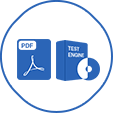Last Update 1 hour ago Total Questions : 80
The SAP Certified Associate - Managing SAP S/4HANA Cloud Public Edition Projects content is now fully updated, with all current exam questions added 1 hour ago. Deciding to include C_S4PM_2504 practice exam questions in your study plan goes far beyond basic test preparation.
You'll find that our C_S4PM_2504 exam questions frequently feature detailed scenarios and practical problem-solving exercises that directly mirror industry challenges. Engaging with these C_S4PM_2504 sample sets allows you to effectively manage your time and pace yourself, giving you the ability to finish any SAP Certified Associate - Managing SAP S/4HANA Cloud Public Edition Projects practice test comfortably within the allotted time.
Why are non-standard scope items activated in the starter system when implementing SAP S/4HANA Cloud Public Edition?
What accelerator can help you document the configuration definition in the Explore phase?
Which of the following is the customer's responsibility in both on-premise and private cloud scenarios?
Which solution is designed to help customers understand their environmental, social, and governance (ESG) data?
After integration requirements have been finalized, what is used to analyze, design, and document the integration strategy?
In the SAP Activate prepare phase, the cloud project is set up and officially launched. Which change management activities are usually started in this phase? Note: There are 3 correct answers to this question.
Which tasks are mandatory before you can migrate data for a specific object? Note: There are 2 correct answers to this question.

